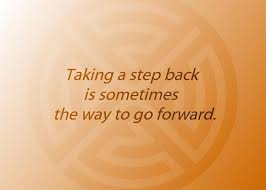 Our national culture seems to be strongly forward-driven and that’s important. And I tend to respond to its influence by saying things like “press on,” and “lead from the front.”
Our national culture seems to be strongly forward-driven and that’s important. And I tend to respond to its influence by saying things like “press on,” and “lead from the front.”
Nevertheless, I have been thinking that the problem in American policing today will not be helped by urging police to move forward — but rather helping them to move back.
What I mean is this: The police warrior mentality and militarization within the ranks will not be solved by moving forward (which could be “more of the same”) but rather by urging them to go back and recover what has been lost.
A good example of what I am saying is the method of community policing (which most pundits including me and the President’s Task Force) happen to believe is a good thing. The problem here is how we define Community-Oriented Policing (COP).
Through the late 1960s and deeply into the 80s, a new way of policing began to emerge. It was really in response to two national commissions on policing which laid out in no uncertain terms that we had a major disconnect in the relationships police had with the African-American community.
Many of us working the street during that era came to believe that police could do a much better job in working with people of color and the way to do this was, essentially, to get closer, to be more empathetic and respectful, to listen, and work together on solving community-identified problems.
But we needed more than training or better public relations, we needed to significantly change the patrol/policing service model to these communities and, eventually, to all of policing.
The “two-officers-in-a-patrol-car” focused on three-shift, time of day policing just couldn’t cut it. The new model became one officer assigned to a specific neighborhood and empowered to help neighborhood residents “fix” problems they saw in their community. It was then only a short step onto Herman Goldstein’s concept of “Problem-Oriented Policing” (POP). We quickly came to realize that when the two concepts are combined (COP + POP) magic happens.
It was clear to many of us who then were in leadership positions that the combination of neighborhood-oriented, problem-solving policing delivered by educated and highly-trained, respectful and controlled police was the future to which we aspired and the solution to problems that existed for years between police and people of color.
But then we ran out of time. Our careers were approaching the 30-year mark and it was time for us to retire. Around the same time, 9/11 happened, our nation went to war and, in many cases, dragged police along in a national tide of fear and anxiety from which they had yet to recover.
Ratchet forward now to today. Police feel under siege. What seemed to work no longer does. Community expectations are very high: they want, even demand, that police be more controlled in their use of force. They expect their police to be highly respectful and to work with them on community problems. And that, to me, sounds very much like the old Community-Oriented Policing model.
I strongly believe that for our nation’s police to move forward they must first move back — move back into the 1980s model of community and problem-oriented policing, seize it, improve on it and then move forward.
If the reader is a little fuzzy on what I mean by this here is my definition — what it is and is not:
COMMUNITY-ORIENTED POLICING
IS IS NOT
Collaborative guardians. Dominating warriors.
Close to people. Centralized.
Citizen’s problems. Police problems.
Broad problem-solving. Focused on incidents.
Neighborhoods. Time focused (shift).
Supports citizen values. Supports police values.
Quality of life. Statistics and numbers.
Compassionate. Distant; only facts.
Primary style.. A “program.”
Leaders are coaches. Leaders are bosses.
Continuously improve. Stuck in the past.
See my earlier blogs on Neighborhood/Community-Oriented Policing:


1 Comment